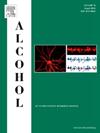Investigation of serum BDNF levels in alcohol withdrawal syndrome with and without other medical co-morbidities
IF 2.9
4区 医学
Q3 PHARMACOLOGY & PHARMACY
引用次数: 0
Abstract
Introduction
Consequences of alcohol use disorder (AUD) are associated with mental and somatic burdens that result in alcohol withdrawal syndrome (AWS), with 30% of AWS cases leading to life-threatening delirium tremens (DTs). So far, biomarkers for tracking abstinence syndrome that are useful in clinical practice have yet to be detected. Current research focuses on brain-derived neurotrophic factor (BDNF) effects on neurogenesis, modulation of plasticity, and its role in the pathogenesis of AWS and DTs.
Aims
The present study aimed to assess pro-BDNF and BDNF concentrations in a group of patients with AWS. Changes in BDNF and prof-BDNF were also evaluated with attention to subgroups of patients with coexisting mental and somatic disorders, with a particular emphasis on the presence or absence of DTs.
Results
The AWS group had a higher concentration of BDNF and a lower concentration of pro-BDNF compared to the control group, and BDNF increased during 7 days of hospitalisation. Patients with comorbid psychiatric disorders had higher levels of pro-BDNF than those without disease and also had higher levels of BDNF at the end of the study than at the beginning. On the other hand, patients with coexisting somatic diseases had higher levels of pro-BDNF at the beginning than at the end of the study, while patients with delirium had higher BDNF levels at the end of the study than at the beginning.
Conclusions
The obtained results indicate that pro-BDNF and BDNF may be useful markers for the course of withdrawal syndrome. In particular, BDNF showed an association with the development of delirium complications. The authors are aware of several limitations of the work only men in the SG, different age between SG and CG.
调查有无其他并发症的酒精戒断综合征患者的血清 BDNF 水平。
酒精使用障碍(AUD)的后果与导致酒精戒断综合征(AWS)的精神和身体负担相关,其中30%的AWS病例导致危及生命的震颤谵妄(DTs)。到目前为止,在临床实践中有用的追踪戒断综合征的生物标志物尚未被发现。目前的研究主要集中在脑源性神经营养因子(BDNF)对神经发生的影响、可塑性的调节及其在AWS和DTs发病机制中的作用。目的:本研究旨在评估一组AWS患者中BDNF和BDNF的浓度。BDNF和pro -BDNF的变化也被评估,并关注患有精神和躯体疾病的患者亚组,特别强调是否存在DTs。结果:与对照组相比,AWS组BDNF浓度较高,pro-BDNF浓度较低,且BDNF在住院7天内升高。患有精神疾病的患者比没有疾病的患者有更高水平的BDNF,并且在研究结束时比开始时有更高水平的BDNF。另一方面,患有共存躯体疾病的患者在研究开始时的BDNF水平高于研究结束时,而谵妄患者在研究结束时的BDNF水平高于研究开始时。结论:BDNF pro和BDNF可能是戒断综合征病程的有用标志物。特别是,BDNF显示与谵妄并发症的发展有关。作者意识到这项研究的局限性,即研究对象仅为男性,研究对象与研究对象的年龄不同。
本文章由计算机程序翻译,如有差异,请以英文原文为准。
求助全文
约1分钟内获得全文
求助全文
来源期刊

Alcohol
医学-毒理学
CiteScore
4.60
自引率
4.30%
发文量
74
审稿时长
15.6 weeks
期刊介绍:
Alcohol is an international, peer-reviewed journal that is devoted to publishing multi-disciplinary biomedical research on all aspects of the actions or effects of alcohol on the nervous system or on other organ systems. Emphasis is given to studies into the causes and consequences of alcohol abuse and alcoholism, and biomedical aspects of diagnosis, etiology, treatment or prevention of alcohol-related health effects.
Intended for both research scientists and practicing clinicians, the journal publishes original research on the neurobiological, neurobehavioral, and pathophysiological processes associated with alcohol drinking, alcohol abuse, alcohol-seeking behavior, tolerance, dependence, withdrawal, protracted abstinence, and relapse. In addition, the journal reports studies on the effects alcohol on brain mechanisms of neuroplasticity over the life span, biological factors associated with adolescent alcohol abuse, pharmacotherapeutic strategies in the treatment of alcoholism, biological and biochemical markers of alcohol abuse and alcoholism, pathological effects of uncontrolled drinking, biomedical and molecular factors in the effects on liver, immune system, and other organ systems, and biomedical aspects of fetal alcohol spectrum disorder including mechanisms of damage, diagnosis and early detection, treatment, and prevention. Articles are published from all levels of biomedical inquiry, including the following: molecular and cellular studies of alcohol''s actions in vitro and in vivo; animal model studies of genetic, pharmacological, behavioral, developmental or pathophysiological aspects of alcohol; human studies of genetic, behavioral, cognitive, neuroimaging, or pathological aspects of alcohol drinking; clinical studies of diagnosis (including dual diagnosis), treatment, prevention, and epidemiology. The journal will publish 9 issues per year; the accepted abbreviation for Alcohol for bibliographic citation is Alcohol.
 求助内容:
求助内容: 应助结果提醒方式:
应助结果提醒方式:


